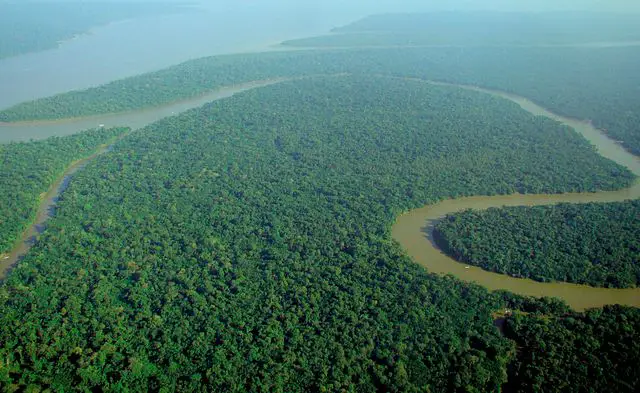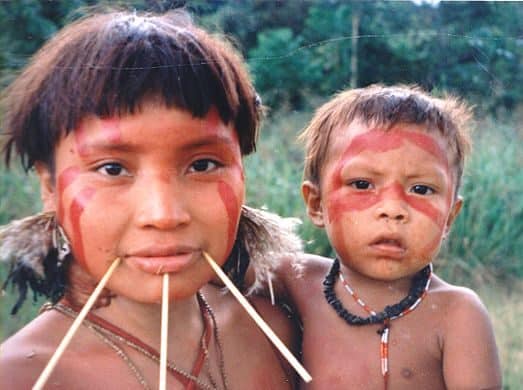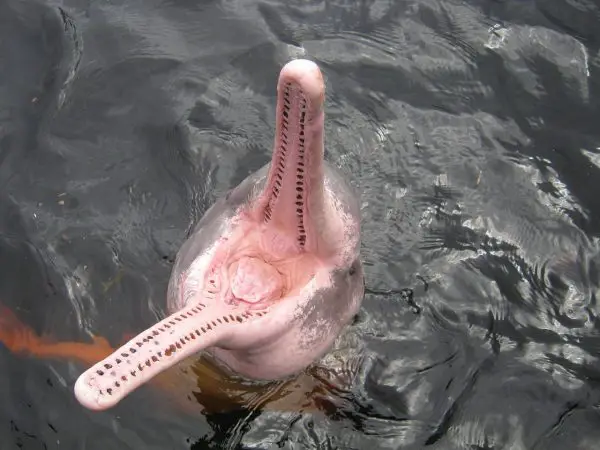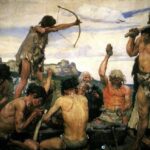Forests that receive an annual rainfall between 250 cm and 450 cm (i.e. 98 inches and 177 inches) are classified as Rainforests. The Amazon Rainforest is the biggest in the world well known for its biodiversity. We have gathered a complete set of Amazon Rainforest Facts For Kids that will help you in learning all the Amazon Rainforest Information that you need to know. You are going to learn about its name, location, features, geographical characteristics, landscape, size, length, rivers, layers, ecosystem, biome, species statistics, flora & fauna, deforestation, conservation, importance, rainfall, weather, climate, people, houses, languages, resources, oxygen facts and many other interesting facts about the amazon rainforest.
Amazon Rainforest Facts For Kids
1. What Is The Amazon Rainforest – Amazon Rainforest Description
- The Amazon rainforest is the most wider tropical rainforest in the world.
- It covers most of Northwestern Brazil and further extends into South American countries like Peru, Columbia, Venezuela, Bolivia, Ecuador, and Guyana.
- The Amazon River flows through the north of the rainforest.
- The Amazon rainforest is well-known for its biodiversity and rich ecosystem.
- It is home to approximately 40,000 plant species, 3,000 types of fish, 1,300 species of birds, 430 species of mammals, and up to 2.5 million different species of insects.

2. Why Is The Amazon Rainforest Called The Amazon Rainforest
- It is a common belief that Amazon got its name after a fight between Spanish explorer Francisco de Orellana and Tapuyas and other native tribes of Amazon.
- In the fight, the tribe’s women also fought alongside men, which was their custom.
- Orellana gave the name Amazonas to the region, which he derived from the Amazons of Greek mythology.
- In Greek mythology, the Amazons were a tribe of warrior women of Iranian origin.
3. Where Is The Amazon Rainforest Located – Where In The World Is The Amazon Rainforest
- In the world, the Amazon rainforest is located in the South American continent.
- It covers regions of 8 countries and a territory.
- Mostly, it is spread over 3 countries; 60% in Brazil, 13% in Peu, and 10% in Columbia.

4. What Country Is The Amazon Rainforest In – Amazon Rainforest Countries
- The Amazon rainforest is located in the following countries:
- Brazil (60% of the Amazon rainforest)
- Peru (13%)
- Columbia (10%)
- The remaining 17% is found in:
- Venezuela
- Ecuador
- Bolivia
- Guyana
- Suriname
- French Guiana (an overseas region of France)
5. Brazil Amazon Rainforest
- In Brazil, up to 60% part of the Amazon rainforest is found.
- It covers much of the northwestern region of the country.
6. Is The Amazon A Tropical Rainforest – Amazon Tropical Rainforest
- Yes, the Amazon rainforest is a tropical rainforest.
- It means it lies in a tropical region.
- While a tropical region is a region on the Earth that surrounds the equator.
7. Features Of The Amazon Rainforest
- The Amazon rainforest is a tropical rainforest located in South America that covers most of the Amazon Basin.
- It is the largest rainforest in the world and represents up to half of the remaining rainforests of the planet earth.
- It covers 5.5 million km² areas within 9 countries.
- 60% of the Amazon rainforest is located in Brazil while the remaining 40% is located in Peru, Colombia, Bolivia, Venezuela, Ecuador, Guyana, Suriname, and French Guiana.
- It is also the most biodiverse tropical rainforest in the world with about 40,000 species of plants, 430 species of mammals, 1,300 birds, 3,000 types of fishes, and 2.5 million different species of insects.
- The Amazon rainforest is also home to about 400-500 native Amerindian tribes.
8. What Is The Amazon Rainforest Famous For
- The Amazon rainforest is famous for:
- Being the largest tropical rainforest in the world
- Biodiversity
- Amerindian tribes living there
9. Amazon Rainforest Geographical Features – Amazon Rainforest Characteristics
- The Amazon rainforest is located in the South American continent.
- With an area of 5,500,000 km² (2,100,000 sq mil), it covers one-third part of the whole continent.
- It extends from the Andes mountains in the West to the Atlantic Ocean in the East for up to 4,828 km (3,000 miles).
- In the Northside, it surrounds the equator and that is why it is called a tropical rainforest.
- Up to 60% of the Amazon rainforest covers parts of Brazil and the remaining 40% covers parts of Peru, Columbia, Bolivia, Ecuador, Venezuela, Guyana, Suriname, and French Guiana.
- 6,400 km long Amazon River (the second greatest river of the world after the Nile River) flows throughout the Amazon rainforest.
- The rainforest also covers most of the Amazon Basin.
10. Amazon Rainforest Landscape
- The landscape of the Amazon rainforest possess:
- One in ten known species of plants and animals on the planet Earth
- Half of the world’s remaining tropical forests
- 6,598 km of the winding rivers
11. How Big Is The Amazon Rainforest – Amazon Rainforest Size – Amazon Rainforest Area
- The area of the Amazon rainforest is 5.5 million km² (2,100,000 sq mil).
12. How Long Is The Amazon Rainforest
- From the west to east (from the Andes mountains to the Atlantic Ocean), the length of the Amazon rainforest is up to 3,000 miles (4,828 km).
13. Amazon Rainforest Size Comparison
- If we compare the size of the Amazon rainforest (5,00,000 km² area) with other countries and regions, we will know that:
- It is double the size of India (3,287,263 km²)
- 17 times of the area of the entire UK and Ireland (UK 242,495 km² + Ireland 84,421 km² = 326,916 km²)
- Of the United States (9,833,000 km²) Amazon rainforest is as big as 0.56 times
- Of Europe (10,180,000 km²) it is as big as 0.54 times
14. How Old Is The Amazon Rainforest
- It is believed that the Amazon rainforest is about 55 million years old.
15. Amazon Rainforest River
- The Amazon rainforest river includes the Amazon River and its tributaries.
- By discharge and water volume, the Amazon River is the largest in the world.
- While by length, it is slightly shorter than the Nile River.
- According to a recent 2014 study, the Amazon River originates in the Andes mountains in Peru.
- The headwaters of the Mantaro River is its main source of origin.
- The length of the Amazon River is up to 6,400 km (4,000 miles), flows throughout the Amazon rainforest, and finally discharge into the Atlantic Ocean.
- Its basin, the Amazon Basin, has an area of about 7,050,000 km² (2,720,000 miles) and is the world’s largest drainage basin.
- 20% of the world’s freshwater discharge to the ocean is provided by the Amazon River.
- Amazon River is home to a large number of unique aquatic species, some of which are endangered, such as boto (Amazon River dolphin) and Black Caiman.

16. Facts About The Amazon Rainforest Layers
Like all rainforests, the Amazon rainforest also has four layers:
-
Emergent Layer
It consists of the outermost regions of the giant trees. This layer is greatly exposed to sunlight and also endure harsh conditions like low humidity, high temperatures, and strong winds.
-
Canopy Layer
It is a broad layer consisting of tightly packed tree branches and leaves. This layer of the rainforest is the most inhabited region, where about 90% of the rainforest species are found.
-
Understory Layer
It has young trees, trunks of large trees, and shrubs. This layer receives a lower amount of sunlight.
-
Forest Floor Layer
This is the damp and dark ground layer. This layer receives a very little amount of sunlight. Large rainforest animal species are found in this layer.
17. Amazon Rainforest Ecosystem – Amazon Rainforest Biome
- A biome is a large geographic region of flora and fauna with a specific climate.
- Rainforest is a type of biome.
- Rainforests share the non-living or abiotic (humidity, temperature, soil type, and rainfall) and living or biotic factors (animals and plants).
- The ecosystem of the Amazon tropical rainforest can be divided into layers called the tropical levels.
- The basis of these tropical levels is the energy getting procedure of separated species.
- Species are divided into 4 trophic levels:
- Producers are the species that prepare their food themselves such as plants.
- Primary consumers are the species that get their energy from producers, for example, leaf cutter ants, butterflies, and other insects.
- Secondary consumers are the species that eat primary consumers, such as frogs, vampire bates, iguanas.
- Tertiary consumers are the species that eat secondary as well as primary consumers, such as pumas, jaguars, and crocodiles.
18. What Lives In The Amazon Rainforest – Amazon Rainforest Species
- The Amazon rainforest is famous for its biodiversity and is home to:
- 400 to 500 indigenous Amerindian tribes
- 1,300 species of birds
- 427 species of mammals
- More than 400 amphibian species
- 373 species of reptiles
- Around 2.5 million different species of insects
- About 3,000 types of fish (found in the Amazon river)
- At least 40,000 plant species (according to WWF)
19. What Animals Live In The Amazon Rainforest – Amazon Rainforest Animals List
- The Amazon rainforest is home to wildlife of all shapes and sizes.
- Of the known animal species, one in ten lives in the Amazon rainforest.
- While one in five known bird species is found in the Amazon rainforest.
- The most famous animals of the Amazon rainforest are:
- Amazon river dolphin
- Giant otter
- Black caiman
- Green anaconda
- Ukaris
- Arrau turtle
- Brown-throated sloth
- Red brocket
- Harpy eagle
- Green Iguana
- Glass frog
- Leafcutter ant
20. How Many Animals Live In The Amazon Rainforest
- The estimated number of animal species that live in the Amazon rainforest is 10 million.
21. Endangered Animals In The Amazon Rainforest – Endangered Species In The Amazon Rainforest
- The following are the endangered species in the Amazon rainforest:
- Amazon River dolphin
- Amazonian manatee
- South American tapir
- White-cheeked spider monkey
- White-bellied spider monkey
- Brown-throated sloth
- Black caiman
22. Mammal Amazon Rainforest
- The following are some of the most famous mammals found in the Amazon rainforest:
- Amazon River dolphin
- Giant otter
- Amazonian manatee
- South American tapir
- Red brocket
- Pygmy marmoset
- Short-eared dog
- White-lipped peccary
- Pteronura
- Ukaris
- White-cheeked spider monkey
- White-bellied spider monkey
- Brown-throated sloth
- Southern Amazon red squirrel
- Dwarf little fruit bat
- Dark fruit-eating bat
- Eastern lowland olingo
- Greater long-nosed armadillo
- Black agouti
- Woolly mouse opossum
23. Amazon Rainforest Snakes – Amazon Rainforest Snakes Facts
- Snakes are cold-blooded creatures and their bodies can not maintain a constant temperature.
- So they mostly inhabit the areas where they face a little change in environmental temperature.
- Rainforests are a favorite habitat of snakes because the climate remains almost the same throughout the year.
- A large variety of snakes live and flourish in the Amazon rainforest.
- Some of them are venomous while some are non-venomous.
- The following are some of the snake species found in the Amazon rainforest:
- Green Anaconda is a non-venomous snake species. It is the heaviest and also one of the longest in the known snake species of the world.
- Boa Constrictor is also a non-venomous snake species found in the Amazon rainforest.
- Lachesis or Bushmasters are venomous snakes of the Crotalinae (commonly called pit viper) sub-family.
- Bothrops insularis or Golden lancehead is also a venomous pit viper species. It is one of the most dangerous species of snakes.
- Bothriechis Schlegelii or eyelash viper is also venomous and pit viper species.
- Coral snakes are a wide group of venomous snakes found in the Amazon rainforest.
24. Amazon Rainforest Insects
- The Amazon rainforest is home to about 2.5 million species of insects.
- The most abundant type of insect found in the Amazon rainforest is ants. Of ants, the Gigantiops destructors have large eyes and excellent vision while the bullet ant is famous for its most painful sting on the Schmidt sting pain index.
- Other insects include caterpillars, beetles, bugs, jumping sticks, leaf katydid, praying mantis, weevils, spiders, and butterflies.
25. Amazon Rainforest Birds
- More than 1,300 species of birds are found in the Amazon rainforest.
- Some of the most beautiful and well-known birds are:
- Hyacinth Macaw
- Scarlet Macaw
- Plum-throated Cotinga
- Blue-fronted Amazon
- Spectacled owl
- Crimson Topaz (hummingbird)
- Amazon Kingfisher
- Oropendolas
- King Vulture
- Yellow-headed Caracara
26. Amazon Rainforest Lizards
- The known number of lizard species found in the Amazon rainforest is over 100.
- Some of them are:
- Iguana
- Bridled forest gecko
- Turnip-tailed gecko
- Banded tree anole
27. Amazon Rainforest Habitat – Amazon Rainforest Environment
- The Amazon rainforest is a kind of tropical rainforest habitat.
- It means it is located near the equator and receives a huge amount of rainfall every year.
- Amazon rainforest has a warm, wet, and dense environment due to which millions of plant and animal species are found there.
- Researchers believe that about half of the animal and plant species would be found in the rainforest habitat.
28. Amazon Rainforest Flora – Amazon Rainforest Plants List
- Amazon rainforest has a huge collection of plant species.
- According to botanical experts, every 2.5 hectares of the forest has about 700 different species of trees and about double the number of other plant species.
- Tall trees are in abundance in the Amazon rainforest and some even have up to 130 meters in height.
- According to scientists, about 390 billion trees of about 16,000 species are found in the Amazon rainforest.
- Research in 1999 estimated that every hector of the Amazon rainforest has an average of 356 ∓ 47 tonnes of plant biomass. While this number is 90,790 tonnes for a one-kilometer square.
- Currently, the number of registered plant species of social and economic interest has been estimated as 438,000.
- There are many more plant species in the Amazon rainforest that have to be discovered.
- Some of the well-known plant species found in the Amazon rainforest are:
- Heliconia (Heliconia latispatha)
- Orchid
- Passion Flower (Passiflora edulis)
- Cacao (Theobroma cacao)
- Giant Water Lily (Victoria Amazonica)
- Bromeliad
- Rubber Tree (Hevea brasiliensis)
- Coffee Plant (Coffea arabica)
- Sapodilla (Manilkara zapota), the sap of this plant has been used for the creation of the first chewing gum.
- Pitcher plant (Nepenthes sp)
- Brazilian nut tree (Bertholletia excelsa)
29. Amazon Rainforest Deforestation Statistics – Amazon Rainforest Deforestation Facts
- The conversion of forested land to non-forested land is known as deforestation.
- In the Amazon rainforest, the main reasons for deforestation are cattle ranching, land development for agriculture, wood poaching, search for fossil fuel reservoirs, and human settlements.
- In the last 30 to 40 years, the Amazon rainforest lost about 20% of its level. Only in Brazil, this is roughly equal to 770,000 km² area.
- In other words, the Amazon rainforest suffered deforestation in the last 40 years more than the total previous 450 years.
- In 1970, the construction of the Trans-Amazonian highway started that appeared as a major threat to the Amazon rainforest. However, the environmental damage has been limited as the highway has not been completed yet.
- The deforested area in the Amazon increased from 160,000 to 227,000 sq mil (415,000 to 587,000 km²) only between 1991 and 2000.
- From 2000 to 2005, the deforestation rate was 8,646 sq mil (22,392 km²) per year, which was 18% higher than the previous five years.
- There is uncertainty about the future of the Amazon rainforest. Some estimates claim that in the upcoming 20 years, 20% more of the Amazon rainforest will be lost.
30. Amazon Rainforest Conservation
- From 2002 to 2006, up to 60% drop has been recorded in the deforestation and the conserved land has been almost tripled in the Amazon rainforest.
- About 250,000,000 acres (1,000,000 km²) have been put to some types of conservation, which gradually increased to a current amount of 430,000,000 acres (1,730,000 km²).
- In April 2019, Ecuador’s court banned the activities of oil exploration in the Amazon rainforest conducted on 1,800 km².
- In July 2019, Ecuador’s court prohibited the government to sell any forest territory to oil companies.
31. Why Is The Amazon Rainforest Important
- The Amazon rainforest is known as the lungs of the planet earth.
- As the world’s largest rainforest, it plays a wide role in the filtering and reprocessing of carbon dioxide.
- Trees and other green vegetation of the Amazon rainforest absorb a huge amount of carbon dioxide for the production of energy through photosynthesis and release oxygen back to the environment.
- Through this process, the Amazon rainforest provides 20% of the world’s oxygen and plays a wide role in reducing global warming.
- Amazon rainforest also exchanges a huge amount of water and energy with the atmosphere and controls the regional climate.
- A large variety of medicinal plants come from the Amazon rainforest.
32. Amazon Rainforest Rainfall – Amazon Rainforest Precipitation
- Precipitation means any product produced due to the condensation of the water vapor in the atmosphere that falls on the ground under gravity, such as rain, snow, drizzle, sleet, graupel, and hail.
- Amazon rainforest receives heavy rainfall.
- The least amount of the annual rainfall is about 80 inches while in some areas it reaches about 430 inches.
- The rainfall occurs throughout the year without any “wet” and “dry” seasons.
- Each tree in the canopy transpires approximately 760 liters (200 gallons) of water per year, which contributes to the rain clouds formation.
- According to some estimates, the Amazon rainforest creates as much as 50% of its precipitation.
33. Amazon Rainforest Climate Facts – Amazon Rainforest Weather
- Amazon rainforest has a hot and humid climate like any other tropical rainforest.
- All around the year, the temperature ranges from 72 to 93 °F.
- The humidity ranges from 65 to extremely higher 82% due to which the weather feels extremely hot.
- Due to higher humidity and heavy rainfall, the Amazon rainforest has quite a monsoon-like climate.
34. Amazon Rainforest Temperature
- The temperature in the Amazon rainforest persists around 28 °C throughout the year.
- However, it feels much hotter due to the higher humidity in the air.
- The difference in temperature between day and night is greater than the temperature difference between the two seasons.
35. Amazon Rainforest Tribes Facts
- In the Amazon rainforest, 400 to 500 native Amazonian Indian tribes live.
- About 50 of these tribes are believed they have no contact with the outside world.
- The tribes have their society, language, culture, and rituals.
- The Yanomami tribe is the biggest tribe of the Amazon rainforest with 20,000 members.
- While the Akuntsu and Kanoe tribes are considered as the smallest that have less than 30 members.
- People of the tribes grow vegetables and fruits such as corn, papaya, banana, beans, super fruit, passion fruit, and berries.
- Human activities of the outside world like deforestation, wars, drug trafficking, and diseases are threats to the survival of the Amazonian tribes.
- Spiritual ceremonies and rituals are usual practices in the tribes. One of their rituals is called Satere Mawe, in which young boys must have to wear gloves filled with bullet ants to become a man.

36. Amazon Rainforest People
- In the Amazon, more than 30 million people live, including the native tribal people and ethnic groups.
- The number of native people living in the Amazon Basin has been poorly measured.
- However, up to 9% (2.5 million) of the population is classified as “indigenous” people in 8 Amazon countries and French Guiana.
- All the people there rely on nature for food, clothing, and traditional medicines.
37. Amazon Rainforest Houses – Homes In The Amazon Rainforest
- People of the Amazon rainforest usually live in communal houses.
- The houses of indigenous people are also communal shaped.
- They made their houses from bamboo with the roofs covered with banana or palm leaves and straw.
- Their houses do not have any walls as the weather in the Amazon rainforest does not get cold and no need for walls has been felt.
- There is also not any concept of privacy.
- The people need roofs as there is so much rain in the Amazon rainforest.
- So they built their houses by just supporting the roofs with bamboo poles.
38. Amazon Rainforest Language
- People of the Amazon rainforest mainly speak Portuguese and Spanish languages.
- People of the indigenous tribes speak their languages.
- It has been estimated that indigenous people speak about 180 different languages.
39. Amazon Rainforest Food Facts
- Rainforests have a rich diversity of foods.
- It has been estimated that about 80% of food in the developed world has a rainforest origin.
- Fruits like avocado, bananas, pineapples, and coconuts are richly found in the Amazon rainforest.
- Indigenous people grow corn and cassava and many types of vegetables like potatoes, papayas, and beans.
- When their crops are not fully ripped and they have food scarcity, they eat palm hearts and a plant called pisidawa.
- They also do fishing in the Amazon River and hunt animals for meat.
40. Amazon Rainforest Resources
- The Amazon rainforest is an extremely resourceful piece of land.
- There are huge reserves of timber, gold, bauxite, nickel, copper, tin, and manganese.
- A large quantity of oil also exists underground.
- The region is well-known for the growth of coffee and the production of meat and milk.
- A large number of medicinal plants are found in the Amazon rainforest. These plants are the subjects of scientific research to use their extracts for the treatment of various diseases.
41. Producers In The Amazon Rainforest
- Plants (including trees, herbs, shrubs, and any other types of green vegetations) and fungi are the producers in the Amazon rainforest.
42. Amazon Rainforest Oxygen Facts
- The fact that the Amazon rainforest produces 20% of the world’s oxygen is wrong.
- All the Tropical forests in the world are responsible for 34% of photosynthesis of the world. The Amazon forest is responsible for about half of it i.e. 16% of the total photosynthesis.
- The Amazon Forest consumes about the same amount of oxygen that it produces.
- The plants in the amazon consume more than half (about 60%) of the oxygen produced by them. Photosynthesis happens only in the daytime and at night there is no photosynthesis, so plants consume the oxygen.
- The remaining 40% of the oxygen produced by the Amazon forest is consumed mostly by the microbes for the decomposition of wood and dead leaves.
- So the net contribution of oxygen by the Amazon rainforest is effectively zero.
43. Can You Live In The Amazon Rainforest
- Yes, anyone can live in the Amazon rainforest.
44. Interesting Facts About The Amazon Rainforest – Amazing Facts About The Amazon Rainforest
- The estimated number of trees in the Amazon rainforest is 390 billion belongs to more than 16,000 different species.
- The soil of the Amazon rainforest has extremely poor nutrients (only about 20%). Plants get 80% of their nutrients from themselves through the continuous turnover of dead leaves and shoot into the soil.
- It has been estimated that every square kilometer of the Amazon rainforest has 90,790 tonnes of plant biomass.
- Every canopy tree of the Amazon rainforest transpires about 760 liters (200 gallons) of water per year, which contributes to the production of rain clouds.
- Scientists have been performed research on only about 1% of plants and trees found in the Amazon rainforest. And yet, 25% of all the Western pharmaceuticals are made from the ingredients grown in the rainforest.
- Of the entire world’s food, about 80% has its origin in the Amazon rainforest.
- More than 3,000 types of fruits grow in the Amazon rainforest. Of which only about 200 types are consumed in the Western world.
- It has been estimated that more than 137 species are subjected to extinction every day due to deforestation in the Amazon rainforest.
- Carbon emitted due to the burning of the Amazon rainforest make up about 30% of the world’s carbon emissions.
- In every second, the Amazon River discharges about 55 million gallons of freshwater into the Atlantic Ocean.
- There are about 2.5 million different types of insects found in the Amazon rainforest.
- Of all the animal species, one in ten is found in the Amazon rainforest.
- Of all the known birds, one in five are found in the Amazon rainforest.
45. Amazon Rainforest Map For Kids











